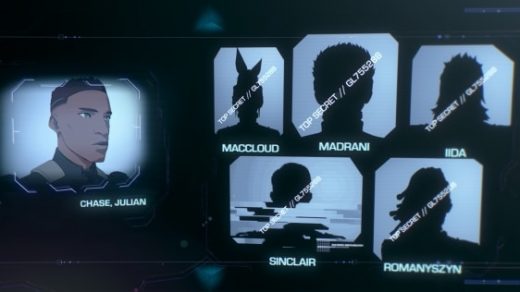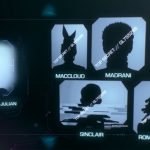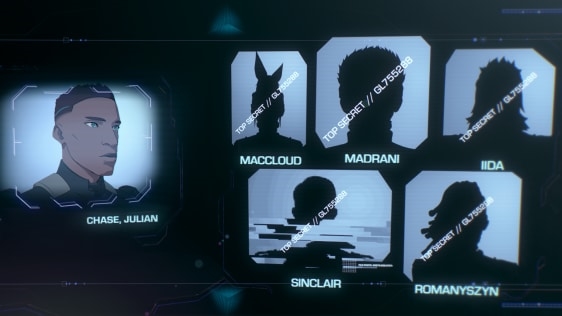Rooster Teeth Reveals The Global Culture War At The Heart Of “Gen:Lock”
When the first two episodes of RWBY premiered in the summer of 2013, it was so hotly anticipated that fans who packed the Austin Convention Center auditorium had created costumes to cosplay the characters, based on just the handful of promotional images that had been released into the wild. Rooster Teeth Productions, the Austin-based digital studio that created the dramatic anime fantasy, had high ambitions for RWBY, but they couldn’t have anticipated what it would become: a web series that attracted a per-episode average viewership comparable to network shows like Supergirl, the first American anime series to ever be exported to Japan, and a property that has been licensed onto backpacks and T-shirts sold at Walmart and Hot Topic.
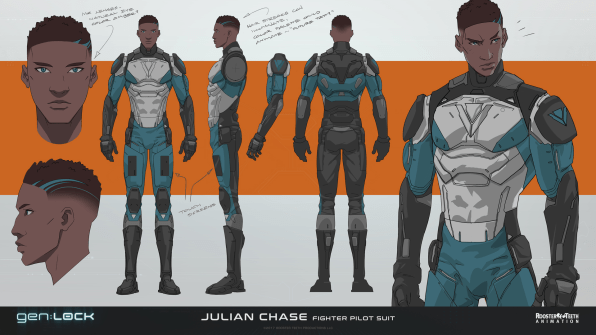
The character design turnaround for Gen:Lock protagonist Julian Chase.
RWBY‘s success changed everything about what Rooster Teeth has become. The company moved into live-action feature filmmaking, hour-long prestige drama, and serialized sitcoms. They went from renting space in a suburban Austin warehouse to essentially taking over Richard Linklater’s sprawling Austin Studios compound. They launched annual events in London and Sydney, and started a video game division (which debuted with the RWBY: Grim Eclipse console game).
Four years later, RWBY is still going strong. But the fact that the series blew up unexpectedly leaves the studio’s leadership with questions: Where do you go from here? How do you continue to grow an audience that boomed in size after your last major launch when it’s time to follow that one up?
No stranger to success, Rooster Teeth first made its mark with Red vs. Blue, a sitcom set inside a Halo-like video game universe that helped launch machinima out from the underground after it launched in 2003. The show has attracted celebrity actors, scriptwriters, and is streamed by both Netflix and Amazon. With more than 400 episodes to date, Rooster Teeth has also sold at least 1 million DVDs, and has more than 200,000 paying subscribers who are eagerly awaiting the start of season 16 in early 2018.
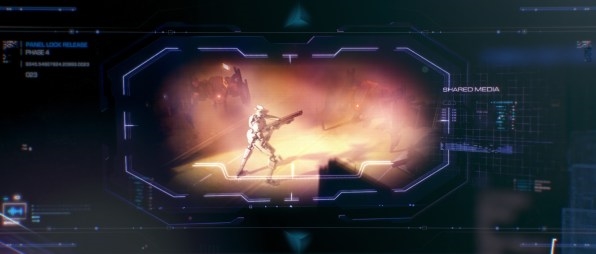
A prototype mech from Gen:Lock.
Early last year, the studio began actively looking for its next big thing. “We put out a call inside the company saying, ‘Hey, anybody who’s got a story idea that they think would be appropriate, come talk to us,’” explains Gray Haddock, head of Rooster Teeth Animation, who wanted to follow up RWBY with another anime series that would appeal to the same fans, while potentially broadening its audience as well. “We started receiving pitches from inside, and went through a round where we identified some properties that were coming from various crew people inside of RT Animation.”
Haddock presented the ideas to the company’s senior creative committee, a group of a half-dozen founders and executives. Ultimately, the one they settled on was one of Haddock’s own, a series called Gen:Lock set on a dystopian future Earth in which our cultural divisions are mostly resolved by people fighting each other while wearing giant “mech” armor.
Rooster Teeth surprised its fans with the announcement of Gen:Lock in the form of a brief video that was shown at the end of its most recent three-day gaming and culture event, RTX. The teaser revealed almost nothing about the show–there was a pair of glowing eyes, a human figure, and a glimpse of an early logo.
Now, Haddock is ready to offer more details of Gen:Lock–and he sat down exclusively with Fast Company to look at some images from the series and reveal its lead protagonist.
“The story of Gen:Lock starts at the beginning of a new global culture war,” Haddock says. “The first episode introduces the very beginning conditions of the war, and will begin to move around a little bit. It’s not necessarily a war between nation-states, but trends that every nation-state tends to have in common—it’s not like the front lines of the war are on the borders, but it could be in the middle of a particular city. People with one set of views are done being patient with people with other views, and there’s a particular portion of the global culture that has recognized that even though they’re spread out among former nation-states, they have certain things in common, and organize to do a territory grab, so they can form new areas around the world that are very much a mono-culture representing just their views. Then you have everyone else who doesn’t agree with that perspective.”
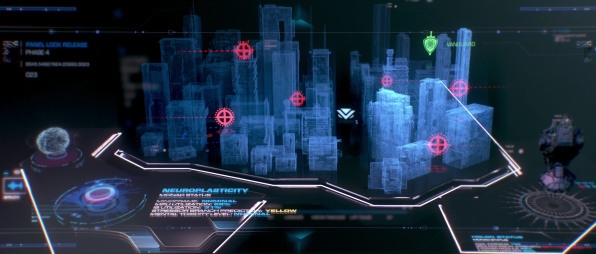
A virtual mission map from Gen:Lock.
As Gen:Lock unfolds, it focuses on issues of identity. Both sides waging the war that Haddock describes struggle with the question of whether it’s possible to defend yourself against a threat while maintaining your ideals. For the individuals doing the fighting, the struggle of identity is rooted in the show’s science fiction setting. Specifically, what it means for people when they get paired up with the “Gen:Lock” technology from which the show draws its name.
Haddock is vague in explaining exactly what Gen:Lock refers to within the context of the show. He says that it’s “a technological breakthrough on the side of the war that we’re following that is very new and raw,” and that “it has to be pressed into service very early, compared to what you’d want to do with this technology, because if they don’t put it into service soon, then it’s not going to matter,” and that’s presumably tied into the “mech” armor that the characters will wear.
With other details, though, he’s more forthcoming: The American protagonist who serves as the audience’s entry point into the series is a young male named Julian Chase. Haddock describes him as an “All-American guy” from Brooklyn who helps form the show’s team after serving as a fighter pilot in its future-military “Vanguard.” That means he already has some battle experience as the new Gen:Lock tech comes online, and he transitions into piloting a mech. “He can apply his former combat experience and signature fighting style in unique ways to what it’s like to drive a mech,” Haddock says. “He’s gone through some tragedy we’ll talk about the first episode of the show, and he’s having to adjust to life after that. He’s charming, funny, and the first guy to break the ice and make sure people around him are doing okay. But over the course of the first year, we’ll learn exactly what he went through that he’s struggling against.
In addition to Chase, the team of characters who make up Gen:Lock‘s season one roster come from Japan, the U.K., the Ukrainian/Russian area, and the Middle East. That makes for a more diverse cast–by race, gender, nationality, or most other ways of considering diversity, according to Haddock–than any Rooster Teeth series to date. “We’ve got a half-dozen people that will form our first Gen:Lock team, and Chase is one of the primaries that we’re going to be following most closely over the course of the first year,” Haddock tells me.
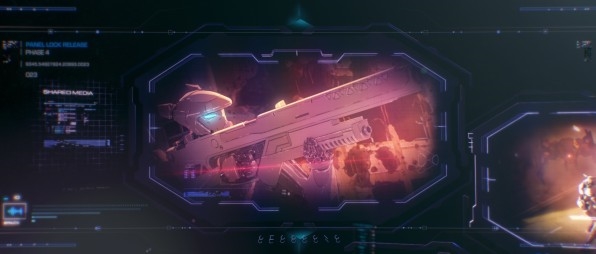
A prototype mech from Gen:Lock.
Despite the early reaction to Gen:Lock at RTX over the summer, as well as the brief teases the series got at the New York Comic-Con in October, Rooster nevertheless faces a rather unique challenge. The studio has to create a series that appeals to the audience that fell in love with RWBY while also offering a series that, aside from the people making it, doesn’t have much in common with its predecessors.
“Gen:Lock serves as an interesting counterpoint to RWBY. We love detailed animation, we love cool action sequences, and we love characters with heart. We want those to be trademarks of what is a Rooster Teeth Animation show. But RWBY‘s got the ‘magical girls fighting monsters’ market cornered right now. When we made RWBY we found all sorts of new audiences that we weren’t anticipating,” Haddock says–but he knows that lightning doesn’t always strike twice. “If we try do to that, we’re going to become paralyzed with all the mind games and pressure you put on yourself trying to manufacture something to various levels of expectation.”
To that end, the project is being unveiled slowly. While Rooster Teeth does have RWBY-like ambitions for the show, there are no plans to launch Gen:Lock by attempting to replicate the licensing success of its predecessor, even though the show’s battle armors and visual aesthetics make it an obvious one for toys and T-shirts.
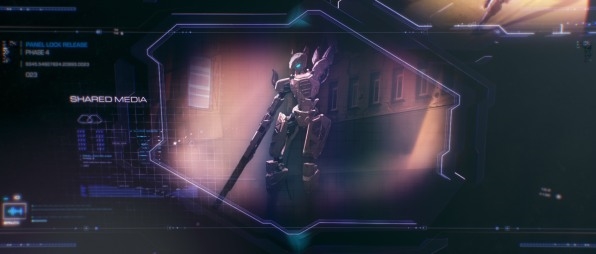
Another view of the prototype mech from Gen:Lock.
“This is not G.I. Joe and the Transformers, where it’s like, ‘Hey, here’s the cartoon! If you like that pilot episode, you can run to Toys ‘R Us now and get the entire wave of the first 30 toys in the line!’” he says. We’re not designing the merch to be sitting there waiting for people on day one. Our focus is on, ‘Let’s make a really cool story, and if everyone emotionally bonds with those characters, and they fall in love with the story and characters in a way that makes them crave a T-shirt with a character they love, or a miniature of a mech on their desk that reminds them of a special moment from the show, that’s when we’ll ramp up on the subject.’”
Ultimately, Rooster Teeth is hopeful that the RWBY audience–and, if the company is lucky, a larger audience that may come from outside its fan base-—will latch onto Gen:Lock, and that they’ll be able to develop future large-scale, ambitious projects that allow them to work in a variety of genres and on a variety of themes, without being tied too much to what came before.
“The one goal with Gen:Lock is we want to take big-idea sci-fi, we want to do more mature storytelling, and we want to explore politics just a little bit–but it still has to be a fun show to watch,” Haddock says. “Our desire is to express some hope in the middle of these big questions we want to ask.”
Fast Company , Read Full Story
(50)

